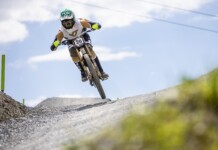By Tom Jow
If tire construction and inflation pressure important for road bike tires, then for mountain and cyclocross bike tires it is even more so. The reason is because mountain and cyclocross bike tires are used in a much wider variety of surface conditions. Ever wonder why those mountain bike race trucks have stacks of tires? Selecting the correct tire for the local conditions can have a significant effect on how you and your bike perform. This month in mechanic’s corner we’ll look at how the elements of tire casing construction, tread compound and pattern, and inflation pressure work together to provide durability, traction, and performance.
The beginning of all tire construction is the casing. This casing consists of a bead, thread layers or plies, and sometimes other materials added for puncture protection. The tire bead is the wire that physically locks the tire to the rim. These can be made of a lightweight, folding material such as Kevlar or a heavier duty material like steel. Kevlar beads can save up to 100 grams (4 ounces) per tire, which doesn’t sound like much but reduction of rotating mass becomes a significant energy savings. Because the steel beads stretch less they are well suited for heavy-duty use. The main tire casing is made up of nylon or cotton threads woven together and measured in threads per inch (tpi). The higher the thread count, the more supple and lighter the tire. A tire with a more supple casing conforms to the trail surface for more comfort and greater traction. The smaller threads can be more fragile and therefore are often used in layers to provide better durability. The thicker threads of lower thread count tires make a stronger, more rigid casing which is ideal for the rugged terrain and higher speeds of downhill use.
The most obvious feature of mountain bike and cyclocross tires is the tread. There are two design characteristics of tire tread, the rubber compound and tread pattern. Measured on a scale of durometer hardness, a tire compound with a lower durometer rating will provide better traction. While not the most important factor, a dual compound tire, with a softer compound on the edges, can be advantageous in some conditions. More important is the actual tread pattern. Tread patterns have as much variation as there are soil types. Tires for dry, packed conditions might be semi-slick, with little or no tread in the center and short, firm knobs on the sides for cornering traction. More often a tire with short small knobs and a tight pattern is better because it offers more traction when the trail has a little loose dirt and small rocks on top. As trail conditions become looser, a more aggressive tread is required. For this or all-around use, a tire with thick, medium depth knobs in a widely spaced pattern is a good selection. The open pattern and deeper knob provide traction in the gravelly or softer soil while the larger knobs will resist deflection under power or braking forces on the harder surfaces. The softest soils or wet and muddy trails demand a more specialized tread. This is where a low durometer compound and mud specific tread is important. The tread for these conditions will be in a wide-open pattern and the knobs will be fewer, taller and with simple square shape. The tall knobs provide deep digging traction and the simply shaped (no nooks and crannies) knobs will shed dirt and mud while riding.
Once a tire is chosen, how much should it be inflated? As discussed in earlier articles, a low tire pressure provides the best traction and rolls over rough terrain easier. There is no magic number, however, because ideal tire pressure will vary with rider size, tire size, riding style and terrain. Some riders use the same tire pressure for all conditions. Others adjust it up or down for “the ride of the day”. Therefore, finding the correct tire pressure requires some experimentation. To find your own best tire pressure, begin with a tire that is pretty firm, approximately 30, 38, or 45 psi for the small, medium and large rider respectively. At this point, the tires should feel a little rough on the trail, like they bounce off of every pebble. Stop every once in a while to let a little air out. Not too much at one time, just a couple quick “psssts” is all it takes. Keep in mind that a tire pressure that is too low will pinch flat too easily. Also, while pedaling fast it may seem bouncy and during hard cornering it may feel unstable and “squirmy”. The ideal pressure feels smooth on rough single track and on rare occasion you can feel the rim hit rocks (without pinch flatting) on very rocky descents.
As with all equipment choices, selection is dependant upon the rider and how it will be used. Will these tires be used for racing? Is the rider lightweight? Are the trails hard packed? Under these circumstances consider a narrow dry condition tire with a tight tread in a width of 1.9 or 2.0 inches. Going on 2-3 hour fun rides? Just purchased a medium travel suspension bike? A wider 2.2 or 2.3 inch with a more aggressive tread will be more appropriate. Suffering on the uphill with that long travel freeride bike just to go down the other side? Going lift served once in a while? Choosing a low thread count heavy duty 2.3 or 2.4 (or even 2.5) inch tire with an aggressive tread will extend the miles of downhill smiles. Taking a 2-week long mountain biking vacation? Bring a truckload.
Got a bike question? Email Tom at 1tomjow@gmail.com.






